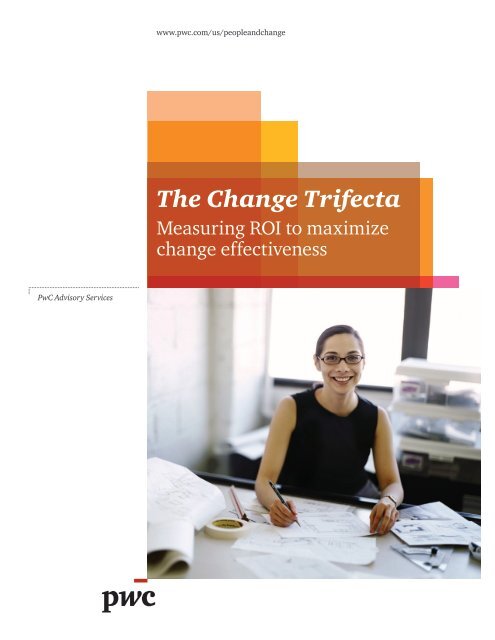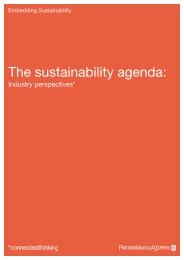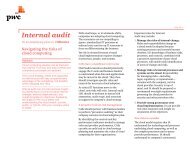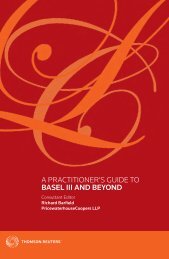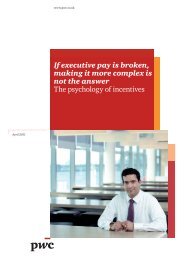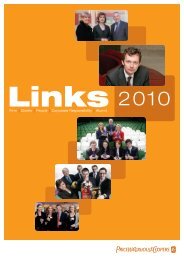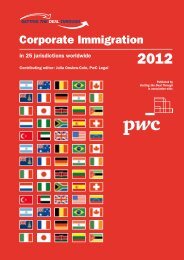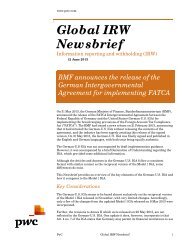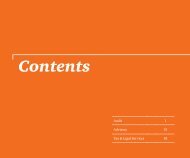The Change Trifecta - PwC
The Change Trifecta - PwC
The Change Trifecta - PwC
- No tags were found...
You also want an ePaper? Increase the reach of your titles
YUMPU automatically turns print PDFs into web optimized ePapers that Google loves.
www.pwc.com/us/peopleandchange<strong>The</strong> <strong>Change</strong> <strong>Trifecta</strong>Measuring ROI to maximizechange effectiveness<strong>PwC</strong> Advisory Services
IntroductionYou are a leader guiding your organization through large-scaletransformation. No doubt you will want the most direct path to measureyour return on investment (ROI) as you progress through the transformation.Even more, you want the most effective means to maximize that ROI. We knowthat change management is a factor that helps you maximize that ROI. <strong>The</strong>challenge is to determine how much change management contributes to thattransformation ROI.Every organization faces this challenge as it seeks to understand andrationalize the cost of managing people through the process of adoptingand embracing change, and making that change “stick.” Spending on changemanagement is a critical element of the business case and the return oninvestment. <strong>The</strong>re is a considerable need to identify the right level of spend,especially on change-related consulting services. <strong>The</strong> challenge becomes evenmore complicated when you add in variables such as scale and complexity.And because all of this seems challenging and complicated, ROI for changeis rarely captured or measured.ii<strong>The</strong> <strong>Change</strong> <strong>Trifecta</strong> | Measuring ROI to maximize change effectiveness
Uncovering common approachesto measuring ROI of your changemanagement investmentRecognizing this dilemma, <strong>PwC</strong>conducted an extensive review ofrecent business research—publishedwithin the last five years—to see ifthere might be a predicting formulato prove return on investment forchange. While the original goal wasambitious, the literature surfacedfour distinct approaches to assessingROI for change. Interestingly,each method tied directly to anorganization’s approach to changemanagement. <strong>The</strong>se four methods are:1. Measuring the relativecontribution that changemanagement provides toa project’s overall ROI. 1In this approach, changemanagement is one of severalenablers that influence positivebenefits and value in the courseof a project, program or strategicinitiative. <strong>The</strong> managed changeframework most often applied inthis approach is comprised of a setof key change factors that havehistorically tested to be mosteffective regardless of initiativeor industry. This framework isoften based on best practice andnot unique to the organization orproject. However, it is acceptedin this approach that managedchange supports the realization ofprogram objectives which, in turn,contributes to a project’s ROI.2. Conducting an in-depthretrospective analysisof similar cases with likeobjectives to identifycommon investment criteriaand parameters. 2Other organizations have madedecisions and realized benefitsthat your organization canleverage when investing in asimilar change initiative. <strong>The</strong>testimony of others will shapeyour understanding of objectives,variables and ROI. Organizations1 Examples of this approach include: Making <strong>Change</strong> Work. White Paper. IBM, 2008; Helping Employees Embrace <strong>Change</strong>,LaClair, J. & Rao, R.(McKinsey Quarterly); 11/2002; Results Delivery SM : Busting three common myths of change management.Litre, P. Bird, A. Carey, G. Meehan, P. (Bain & Company, Bain Brief). 10/29/20102 Examples of this approach include: Measuring the Total Economic Impact of Google Apps. Erickson, J. & van Metre, E.(Forrester); 11/2010; Achieving ROI from Enterprise Communications: A Revolutionary Approach. Thunderhead. (ComputerWeekly.com); 2011; <strong>The</strong> BT Scorecard—Essential Metrics for BT Transformation. Symons, C. Kark, K. Cahill, M. (Forrester);5/24/20113 Examples of this approach include: Performance Dashboards: Measuring, Monitoring, and Managing Your Business, Eckerson,W. (Wiley); 2010; Justifying CRM projects in a business-to-business context: <strong>The</strong> potential of the Benefits DependencyNetwork. Wilson, H., Clark, M., Smith, B. (Industrial Marketing Management). 2011; <strong>The</strong> New HR Analytics: Predicting theEconomic Value of Your Company’s Human Capital Investments. Fitz-enz, J.(AMACOM); 2010; Making WFM Work: BestPractices and ROI Model. DMG Consulting. 2011; (Calabrio); Maximizing your return on people. Bassi, L. and McMurrer, D.(Harvard Business Review); 20074 Examples of this approach include: Developing a change-ready organization: Building internal capacity for change.Contemporary trends in organization development and change. 2011; How to build an agile foundation for change.(<strong>PwC</strong> Connected Thinking); 2008; Organizational health: <strong>The</strong> ultimate competitive advantage. Keller, S. Price, C. (McKinseyQuarterly). 6/2011; Beyond Performance: How Great Organizations Build Ultimate Competitive Advantage. Keller, S. Price,C. (McKinsey). John Wiley & Sons; 2011.that adopt this approach are wiseto consider the organization’sexperience and competence inmanaging change.3. Maintaining a portfolioof change programs andmeasurement systemsthat is customized tothe organization. 3<strong>The</strong> keys to success for thisapproach are ongoing measurementand management of eachelement of a change portfolio.This is a data intensive approach.However, it goes hand in handwith growing and building aninternal change capability whichultimately drives greater ROI.This approach empowersemployees with a breadth oftools and resources to managechange, and a “dashboard” ofmeasures to monitor its success.It effectively develops anorganization of active agents ofchange by quickly growing internalexpertise in change and breakingdown resistance to change.4. Measuring organizationalreadiness or agilityfor change. 4This approach is adopted byagile organizations that acceptthe premise that change is anongoing and never-ending featureof organizational life and deservessignificant investment. Agileorganizations are competitivelyadvantaged and better at adaptingto and embracing change. In theagile organization, change is notsomething to be managed, nor isit a program or strategic initiative.Instead, the organization becomeschange ready, so that everyeffort and action benefits fromthe collective change-readinessof its employees.<strong>PwC</strong>1
When quality, maturity,and agility work together<strong>The</strong>re is no single approach orframework to measure the ROIfor change. However, there arecommonalities inherent in thesefour approaches. In the first twoscenarios, investment in change isviewed as a cost to be justified. Inthe second two, change is viewedas a potential benefit to be realized.Either way, the research is clear;change is a multiplier for realizingfinancial benefits, value or return.But the investment in change alsoproduces unanticipated benefitsthat extend beyond the immediateinitiative and prepare the organizationfor future success.This research combined with ourextensive experience in deliveringvalue through change managementprograms suggests that successfultransformation takes place in anorganization that is characterized by:• High-quality changemanagement practices• A mature programmanagement framework• An agile organization<strong>The</strong>se three characteristics areoften viewed independent of eachother, as evidenced in the fourscenarios previously described.Each characteristic contributes itsown value. But we suggest that changemanagement produces the greatestROI when all three coexist and are atwork concurrently. Collectively, theycreate strategic advantage—not onlyfor the current change initiative—but also for future efforts.Figure 1: <strong>The</strong> <strong>Change</strong> <strong>Trifecta</strong><strong>The</strong> right techniques• Transformation vision• Leadership alignment• Stakeholder engagement• Clear change impact and readiness• Effective communications• Cultural awareness• Workforce transition• Training, adoption and sustainability• Program managementROI: Qualitative and Quantiative<strong>Change</strong> maturity<strong>The</strong> right experience• Program scope• Internal change experts• Relevant, broad change experience• Engaged sponsorshipROI: Qualitative and Quantiative<strong>Change</strong> qualityROI: Qualitative and QuantiativeOrganizationalagility<strong>The</strong> right environment• Agile leadership• Engaged workforce• Commitment to continuous improvement2 <strong>The</strong> <strong>Change</strong> <strong>Trifecta</strong> | Measuring ROI to maximize change effectiveness
To have a deeper conversationabout change at yourorganization, please contact:Ed BoswellPrincipalUS Advisory Services,People and <strong>Change</strong> Leader+1 (617) 530 7504ed.boswell@us.pwc.comToni CusumanoPrincipalAdvisory Services, People and <strong>Change</strong>US <strong>Change</strong> Management Leader+ 1 (415) 307 7376antonia.m.cusumano@us.pwc.comJeff DuftyDirector+1 (312) 298 2127jeff.dufty@us.pwc.comFor this and more Peopleand <strong>Change</strong> publicationsscan the code belowTo download a tag reader, go to http://getscanlife.com© 2012 <strong>PwC</strong>. All rights reserved.“<strong>PwC</strong>” and “<strong>PwC</strong> US” refer to PricewaterhouseCoopers LLP, a Delaware limited liability partnership, which is a member firm ofPricewaterhouseCoopers International Limited, each member firm of which is a separate legal entity. This document is for general information purposes only,and should not be used as a substitute for consultation with professional advisors. PH-12-0143


